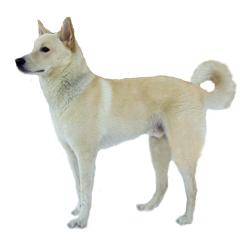
The Breed History
This rare and ancient Israeli breed, which dates back to 2000 BC
originates from ancient Pariah dog stock and is named after the
Land of Canaan. For many years, the dog apparently ran feral in
the Negev desert and the coastal plains. Adoption by some of the
Bedouin tribes helped to sustain their numbers. During the Israeli
War of Independence and in WWII, a number were located and
trained. The first dogs arrived in America in the year 1965. The AKC
accepted the breed in 1997.
Breeding for Function
In ancient times, the dogs served as a herding and guard dog for
flock and home. During the wars of the 20th century in Israel they
served as messengers, mine detectors, trackers, and guard dogs. After
WWII, they were further bred and trained for work as service dogs.
Physical Characteristics
Height at Withers: female 19-23" (48-58.5 cm), male 20-24"
(51-61 cm).
Weight: females 35-45 lb (16-20.5 kg), males 45-55 lb (20.5-25 kg).
Coat: The flat short (0.5-1.5") harsh outer coat is straight and the
inner coat is flat, short and soft. The ruff is more obvious in the
male dog. The accepted colors are:
1. Solid (black, brown) with or without specified markings.
2. Mostly solid white, with or without body patches of color, and
with a matching symmetrical mask. The mask may contain a small
blaze of white only.
Longevity: 12-13 years
Points of Conformation: There are 2 subtypes of dogs, the
so –called "stockdog" type and a longer coated, heavier type
dog. Overall, the standard requires a medium-sized dog with
medium-large erect ears, a long wedge-shaped head and square
conformation. Almond-shaped dark colored eyes are slightly
slanted up. Palpebral rims are colored liver or black, and the stop
is moderate. The neck is moderate in muscling and length and
well arched, not throaty. The topline is level except for a slight
loin arch. The thorax is moderately deep and ribs are well sprung,
and abdomen well tucked up. The "bottle brush" tail may be curled
once over the back when excited, and the length of the tail is to
the tarsus at rest. Limbs are straight boned, and dewclaws may be
removed. The Canaan dogs have compact feet with well-knuckled
toes. Gait is agile, quick, powerful.
Recognized Behavior Issues and Traits
Reported breed characteristics include: Aloof with strangers,
loyal, affectionate with owners, high intelligence, sensitive, good
trainability. They are considered an easy keeping dog; tolerates
warm and cold well. Has moderate shedding tendency, and low
grooming needs. The Canaan has moderate exercise needs, and
needs thorough and early socialization. Some exhibit inter-dog
aggressions, especially inter-male. Canaans are alert alarm barkers,
with a moderate to high barking tendency.
Normal Physiologic Variations
None reported
Drug Sensitivities
None reported
Inherited Diseases
Hip Dysplasia: Polygenically inherited trait causing degenerative
joint disease and hip arthritis. OFA reports 2.2% affected.
Elbow Dysplasia: Polygenically inherited trait causing elbow
arthritis. OFA reports 1.8% affected.
Patella Luxation: Polygenically inherited laxity of patellar
ligaments, causing luxation, lameness, and later degenerative joint
disease. Treat surgically if causing clinical signs. OFA reports 1.7%
affected.
Disease Predispositions
Cataracts: Posterior and nuclear intermediate cataracts
predominate in the breed. Identified in 4.35% of Canaan Dogs CERF
examined by veterinary ophthalmologists between 2000-2005. CERF
does not recommend breeding any Canaan Dog with a cataract.
Persistent Pupillary Membranes: Strands of fetal remnant
connecting; iris to iris, cornea, lens, or involving sheets of tissue. The
later three forms can impair vision, and dogs affected with these
forms should not be bred. Identified in 3.86% of Canaan Dogs CERF
examined by veterinary ophthalmologists between 2000-2005.
Distichiasis: Abnormally placed eyelashes that irritate the cornea
and conjunctiva. Can cause secondary corneal ulceration. Identified
in 2.42% of Canaan Dogs CERF examined by veterinary ophthalmologists
between 2000-2005.
Progressive Retinal Atrophy (PRA): Progressive degeneration of
the retina, eventually causing blindness. 1.93% of Canaan Dogs
CERF examined by veterinary ophthalmologists were diagnosed
with generalized PRA, and 1.93% were labeled suspicious for PRA
between 2000-2005. Undetermined mode of inheritance. CERF does
not recommend breeding any Canaan Dog with PRA.
Idiopathic Epilepsy: Generalized or partial seizures. Control with
anti-seizure medication. Seen at an increased frequency in the
breed. Unknown mode of inheritance.
Cryptorchidism (Retained testicles): Can be bilateral or unilateral.
Seen at an increased frequency in the breed.
Hypothyroidism: Inherited autoimmune thyroiditis. 2.1% positive
for thyroid auto-antibodies based on testing at Michigan State
University. (Ave. for all breeds is 7.5%).
Degenerative Myelopathy (DM): Affected dogs show an insidious
onset of upper motor neuron (UMN) paraparesis. The disease
eventually progresses to severe tetraparesis. Affected dogs have
normal results on myelography, MRI, and CSF analysis. Necropsy
confirms the condition. A direct genetic test for an autosomal
recessive DM susceptibility gene is available. All affected dogs are
homozygous for the gene, however only a small percentage of
homozygous dogs develop DM. Reported as a clinical disease in the
breed. In limited testing, OFA reports a high frequency of Canaan
dogs positive for the DM susceptibility gene.
Isolated Case Studies
None Reported
Genetic Tests
Tests of Genotype: Direct test for a DM susceptibility gene is
available from OFA.
Tests of Phenotype: CHIC Certification: Required tests are; hip
and elbow radiographs, patella examination, CERF eye examination,
and thyroid profile including autoantibodies.
Recomend cardiac evaluation.
Miscellaneous
- Breed name synonyms: Kelef K'naani, Kelev Cana'ani, Canaan.
- Registries: AKC, UKC, CKC, KCGB (Kennel Club of Great Britain),
ANKC (Australian National Kennel Club), NKC (National Kennel Club).
- AKC rank (year 2008): 150 (61 dogs registered)
- Internet resources: The Canaan Dog Club of America:
www.cdca.org (the AKC parent club)
The Israel Canaan Dog Club of America:
www.itb.it/canaan/icdca/ (UKC parent club)
British Canaan Dog Society: www.thecanaandog.co.uk
Photo Gallery of Breed - Canaan Dog - Dog Breed


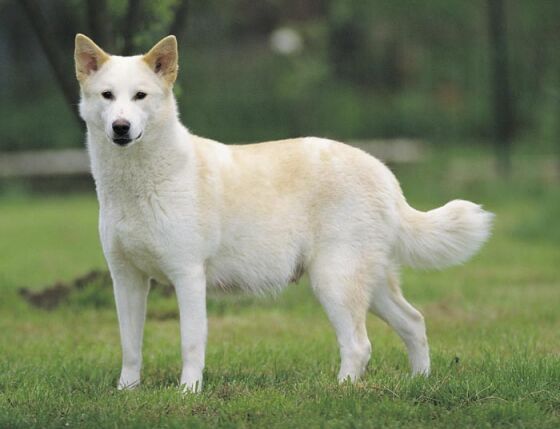

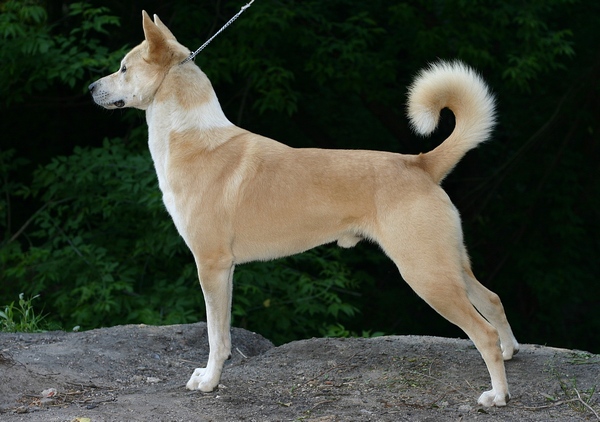
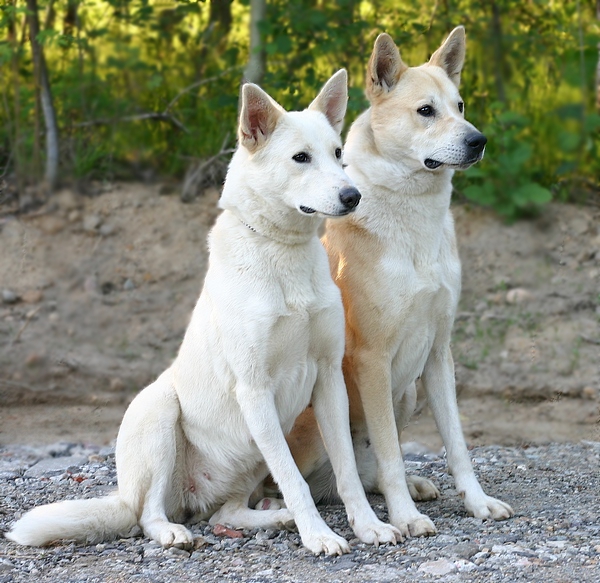

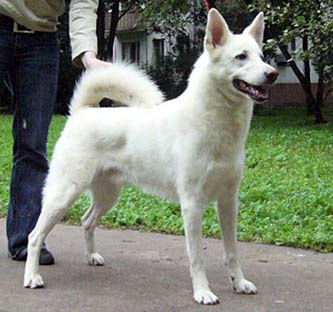
 Animalia Life
Animalia Life